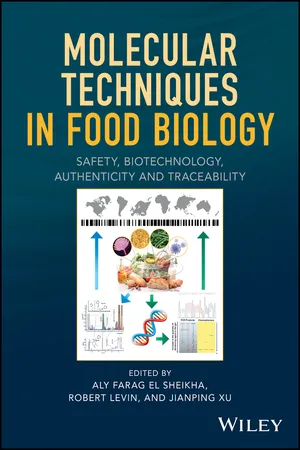
Molecular Techniques in Food Biology
Safety, Biotechnology, Authenticity and Traceability
- English
- ePUB (mobile friendly)
- Available on iOS & Android
Molecular Techniques in Food Biology
Safety, Biotechnology, Authenticity and Traceability
About this book
Molecular Techniques in Food Biology: Safety, Biotechnology, Authenticity & Traceability explores all aspects of microbe-food interactions, especially as they pertain to food safety. Traditional morphological, physiological, and biochemical techniques for the detection, differentiation, and identification of microorganisms have severe limitations. As an alternative, many of those responsible for monitoring food safety are turning to molecular tools for identifying foodborne microorganisms. This book reviews the latest molecular techniques for detecting, identifying, and tracing microorganisms in food, addressing both good foodborne microbes, such as those used for fermentation and in probiotics, and harmful ones responsible for foodborne illness and food quality control problems.
Molecular Techniques in Food Biology: Safety, Biotechnology, Authenticity & Traceability brings together contributions by leading international authorities in food biology from academe, industry, and government. Chapters cover food microbiology, food mycology, biochemistry, microbial ecology, food biotechnology and bio-processing, food authenticity, food origin traceability, and food science and technology. Throughout, special emphasis is placed on novel molecular techniques relevant to food biology research and for monitoring and assessing food safety and quality.
- Brings together contributions from scientists at the leading edge of the revolution in molecular food biology
- Explores how molecular techniques can satisfy the dire need to deepen our understanding of how microbial communities develop in foods of all types and in all forms
- Covers all aspects of food safety and hygiene, microbial ecology, food biotechnology and bio-processing, food authenticity, food origin traceability, and more
- Fills a yawning gap in the world literature on food traceability using molecular techniques
This book is an important working resource for professionals in agricultural, food science, biomedicine, and government involved in food regulation and safety. It is also an excellent reference for advanced students in agriculture, food science and food technology, biochemistry, microbiology, and biotechnology, as well as academic researchers in those fields.
Frequently asked questions
- Essential is ideal for learners and professionals who enjoy exploring a wide range of subjects. Access the Essential Library with 800,000+ trusted titles and best-sellers across business, personal growth, and the humanities. Includes unlimited reading time and Standard Read Aloud voice.
- Complete: Perfect for advanced learners and researchers needing full, unrestricted access. Unlock 1.4M+ books across hundreds of subjects, including academic and specialized titles. The Complete Plan also includes advanced features like Premium Read Aloud and Research Assistant.
Please note we cannot support devices running on iOS 13 and Android 7 or earlier. Learn more about using the app.
Information
Section IV
Fermented Foods and Beverages
10
Revolution in Fermented Foods: From Artisan Household Technology to the Era of Biotechnology
10.1 Introduction
Sadness and good food are incompatible.(Charles Simic, poet)
- ability to produce flavor components that enrich these foods for traditional and new markets
- capability to break down antinutritional factors (e.g., phytic acid) present in some substrates
- production of enzymes to utilize/degrade wastes as substrates
- ability to detoxify toxins and other undesirable secondary products
- thermotolerance and osmotolerance in solid substrate fermentation processes, which are two essential features.
- Where and when did fermentation begin?
- Is the fermented food from the past different from the food of the present era?
- What is the relation between fermented foods and probiotics?
- With the escalation of food safety crises, is it possible to trace the origin of fermented foods?
- What is the future of fermented foods?
10.2 Historical View: Where and When Did Fermentation Start?
Table of contents
- Cover
- Title Page
- Copyright Page
- Dedication Page
- Table of Contents
- List of Contributors
- Preface
- Acknowledgments
- Section I: General Topics
- Section II: Fruits and Vegetables
- Section III: Fish and Meat Products (Non‐Fermented)
- Section IV: Fermented Foods and Beverages
- Section V: Foodborne Pathogens and Food Safety
- Section VI: Future Perspectives
- Index
- End User License Agreement